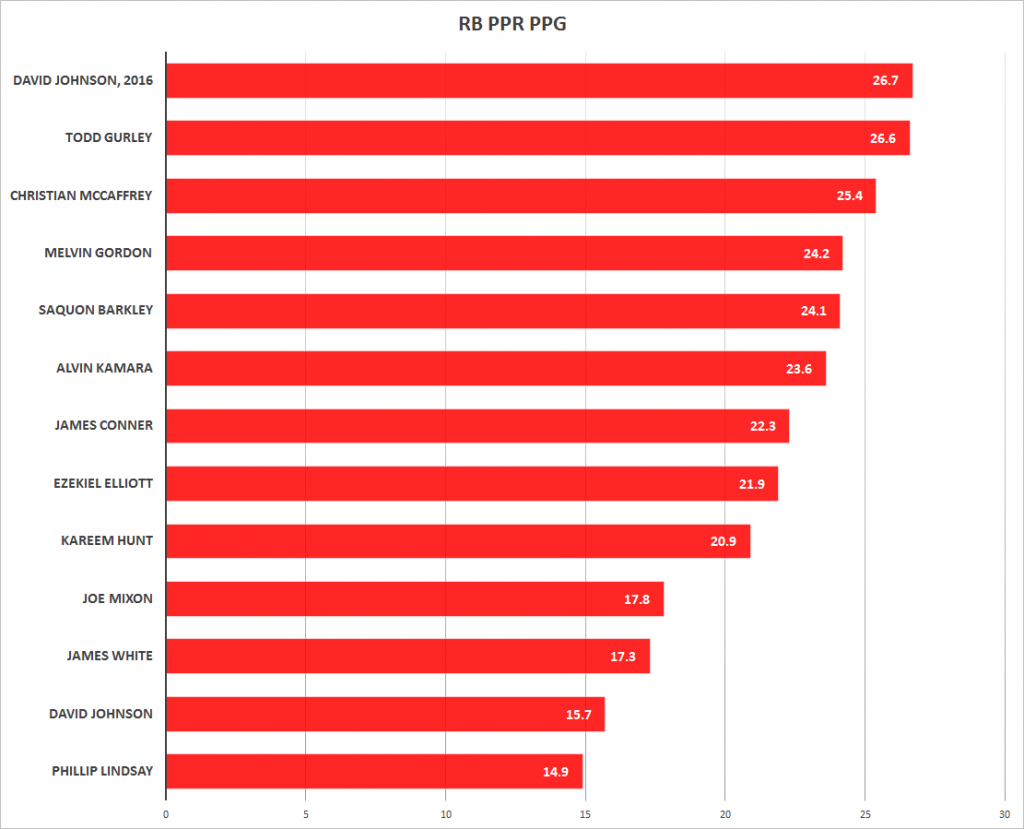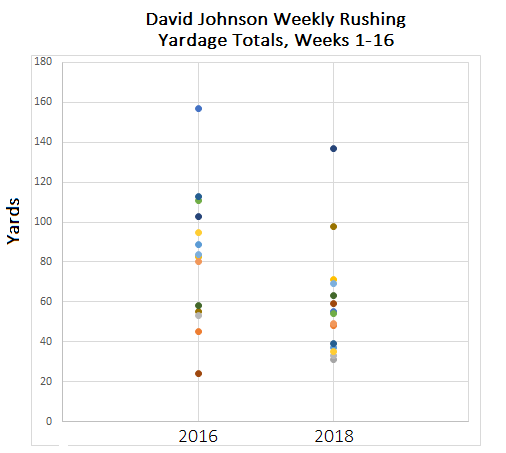Deadpool. DJ Khaled. David Johnson.
In addition to creating an introductory alliteration that would make Dr. Seuss swoon, the aforementioned trio also made headlines in 2016, albeit for a variety of reasons. Arizona Cardinals running back David Johnson demanded the media’s attention with an outstanding season, logging 293 rushes for 1,239 yards, 80 receptions for 879 yards, and 20 total touchdowns. Since that #1 overall finish in 2016, fantasy owners have been anxiously awaiting for Johnson to replicate that level of fantasy success. Despite losing the entire 2017 season to a wrist injury and producing a relatively disappointing season in 2018, David Johnson appears in position for a resurgence in 2019.
However, the elephant in the room still stands: Can we expect a 2019 finish similar to what we saw three seasons ago, or will his 2018 stat-line be more par for the course? The Cardinals’ new coaching staff–and draft acquisitions–definitely offer a tinge of excitement, but how much will that benefit Johnson? Does he still offer top dog upside, or will his investors be left looking foolish for chasing points from a full three seasons ago?
First, let’s talk numbers:

The above graph displays 2018’s top 12 points per game (PPG) values among running backs from weeks 1-16 (the typical window for the fantasy football season which I will use for all statistical analysis in the article), as well as David Johnson’s 2016 campaign. Despite what many would consider to be a relatively disappointing 2018 season, Johnson still had a top ten finish in total fantasy points scored, and his 2016 season would have led the league in points-per-game in 2018.
However, the discrepancy between Johnson’s 2016 and 2018 seasons is enormous. There exists a near 10 point-per-game difference between the two seasons, which justifies some concern for those considering investing significant draft capital to add Johnson to their roster. It almost seems foolish to consider drafting a player who saw such a significant decline after a season off with injury, right? Just look at the difference in his weekly rushing yardage totals in 2016 and 2018:

Each dot on the above graph represents a rushing yardage total in a single game. In 2016, Johnson had nine finishes with 80 or more rushing yards. In 2018, he only had two. In 2016, he was held to less than 40 rushing yards in only one game. In 2018, he failed to break 40 rushing yards five times. His rushing yards per game in 2016 was 82.2, yet only 58.5 in 2018. His yards per attempt fell from 4.3 to 3.6 in that same span.
However, David Johnson has tremendous receiving value, so let’s look at his receiving yardage totals:

Again we see a significant decline in yardage totals between Johnson’s workhorse seasons. The argument could be made that these totals dropped due to a decrease in usage in the passing game, but his yards per reception also saw a decline from 10.9 in 2016 to just 9.4 in 2018. Your immediate conclusion from this data might be that David Johnson is probably nearing the end of his prime and should be ignored in the first round of your draft if you want any shot of sniffing a championship.
However, one must consider why Johnson saw this decline–not only in his total yardage, but also his efficiency numbers. There are many variables at play when discussing running back performance. Age, offensive line play, and play calling can all have a significant impact on an individual’s performance, and any of these factors can make or break a running back.
Age
The first concern in regards to David Johnson’s immediate value is his age. Age and experience in the NFL bring wear and tear on the body, which can (and does) have detrimental effects on player performance over time. Fantasy managers often prioritize youthful players over their older contemporaries for fear that the more seasoned veterans will fall off of the inevitable “cliff” and see a decline in production that results in a poor return on investment. At 27 years old, it is very possible that David Johnson may be approaching the twilight of the prime of his career. However, Johnson’s career reception and rushing attempt totals are interesting to consider when comparing Johnson to some of the younger bell-cow backs with higher average draft positions (ADPs).
David Johnson’s 859 NFL touches are significantly less than Melvin Gordon (Los Angeles Chargers)’s 1,079, Ezekiel Elliott (Dallas Cowboys)’s 1003, and Todd Gurley (Los Angeles Rams)’s 1,229. Those legs are fresh!
Also, keep in mind that he can still find rushing lanes:
https://gfycat.com/hotimpossibledeermouse
….and make defenders miss in space:
https://gfycat.com/scentedoddballcopperhead
…and punch it in on the goal line:
https://gfycat.com/devotedofficialeelelephant
…and make catches downfield:
https://gfycat.com/sinfulelasticflatfish
The talent is still there. The wear and tear is not. So, what’s the issue?
Offensive Line
An oft-cited concern within 2018 fantasy circles was the ineffectiveness of the Cardinals’ offensive line. Cohesiveness as a unit is extremely important for offensive line squads, so the fact that rookie C Mason Cole was the only offensive lineman to start more than 600 snaps over the course of the season speaks volumes about how dire the offensive line’s situation was. Starting OT D.J. Humphries and OG Justin Pugh both suffered season-ending knee injuries in week 10. OG Mike Iupati missed two games due to a neck injury before being placed on IR after a Week 13 knee injury. OT Andre Smith missed three games due to an elbow injury. Mason Cole was the only week 1 starter to start throughout the entire season. While injuries are to be expected, the Cardinals’ line was absolutely decimated by week 17, and David Johnson’s production predictably suffered as a result. For an offensive line to suffer so many season-ending injuries in such a short span is certainly an exception rather than the rule, and David Johnson will likely benefit from a more consistently healthy o-line corps in 2019.
Surprisingly, though, the Cardinals’ offensive line faced similar struggles during Johnson’s 2016 throne-snatching campaign. Pro Football Focus ranked the Cardinals’ line near the bottom of their offensive line rankings (26th overall), citing a season-ending injury to OG Evan Mathis as a major contributor to their poor performance. If offensive line struggles didn’t stop Johnson from posting gaudy numbers in 2016, can his 2018 regression really be entirely attributed to them?
David Johnson is not done. He is not exceptionally old. His tires aren’t bare. He has not lost the vision, skill set, or volume that made him the leading fantasy running back in 2016. His offensive line played poorly in 2018, yes, but they weren’t particularly outstanding in 2016 either. There must be a primary contributor to the considerable decline between his outstanding 2016 campaign and his rather pedestrian top 10 finish in 2018. What changed?
Play Calling
It is no secret that the Arizona Cardinals struggled in 2018. Their 3-13 finish resulted in a mass eviction of coaching personnel and the first overall pick in the 2019 NFL Draft. How does a team with a healthy David Johnson go 3-13?
Abysmal play calling.
Absolutely. Atrocious. Play calling.
David Johnson is the kind of play-making running back capable of catching passes and making defenders miss in open space. Give him ample opportunity to use his devastating skill set and he is fully capable of single-handedly decimating opposing defenses. Just look at this snippet from his 2016 campaign:
https://gfycat.com/shockinggreenchuckwalla
He uses his elite vision to identify the lane outside, cuts to make defenders miss, and scampers down the field for what looks like an easy TD.
So what did the coaching staff do in 2018? Run him up the middle.
Yes, really.
Here is where you can see NFL Next Gen Stats’ charts of David Johnson’s usage on a game-by-game basis. Notice how bunched up and clustered a large majority of his rushing maps are. Those are the kind of rushing maps you would expect with Jerome Bettis in the backfield, not an open-field threat like David Johnson.
This game was the most successful rushing performance for Johnson in 2018. Notice how his rushing trajectories put him outside the tackles, providing him the opportunity to make plays by catering to his strengths.
Now consider this game map. Half of the runs of 5+ yards were directed outside the tackles, despite a large majority of the carries leading between the tackles.
I sympathize with you, Cardinals fans, I really do.
Fortunately, that coaching regime is gone. Kliff Kingsbury is headed to Arizona with aspirations of rejuvenating a stagnant offense. Significant draft capital was used to acquire QB Kyler Murray, WR Hakeem Butler, and WR Andy Isabella. These acquisitions should at least provide some variety in offensive approach to keep defenses honest, assuming the playbook calls for Johnson to do more than run directly into his offensive line. OL Lamont Galliard and OL Joshua Miles were acquired with late-round picks, presumably to provide depth to protect against the seemingly annual offensive line decimation at the hands of injury. Note that no new running backs were drafted to challenge Johnson for his starting spot, and he remains one of the last few workhorse running backs to not succumb to a tortuous running-back-by-committee (RBBC) approach.
It would be fair to consider the 2018 season to be a worst-case scenario for David Johnson. His offensive line play was terrible. His team’s play-calling was terrible. It truly, honestly, could not have been much worse, and yet he finished as a top ten running back. If you subscribe to the belief that 2018 presented the floor of David Johnson, then you really could not do much better with your first-round pick.
David Johnson has proven that he is capable of being a fantasy goldmine in the NFL. He is a true proven commodity in a league full of running back question marks. His freak 2017 wrist injury should not incite injury concerns. Odds are that he will benefit from a healthier offensive line in 2019. He has no significant challenge to his bell-cow volume. He has fewer career touches (read: less wear) than many of his higher ADP contemporaries. His team has made legitimate investments in his offense with no indication of any intention to reduce his workload. A player with his proven top-ten floor and potential #1 upside does not come around very often, and the added excitement of seeing how things play out with the new coaching regime might be enough to convince you to snag Johnson with your first pick.
The upside is there.
Just sayin’.
Photo by Kevin French/Icon Sportswire
Could use more pictures that catch the eyes of the uneducated masses